By Jeffrey A. Rendall, Photos By Jeffrey A. Rendall
MILLSBORO, DE – If there’s an important question in life that you just can’t seem to solve on your own, it’s always a good idea to ask Mom for her opinion.
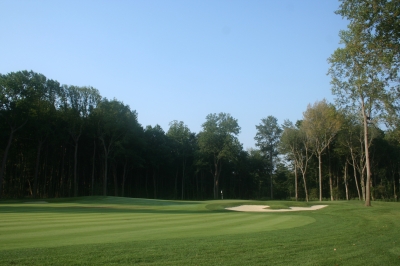 |
| Looking towards the 1st green. Plenty of room to run the ball up on the opening hole. |
Such was the case with Larry Goldstein, developer of The Peninsula Golf & Country Club, near Rehoboth Beach in Delaware. The idea was to develop a golf course to serve as the centerpiece of a new luxury resort housing community, and great care needed to be taken to make sure the course was done right.
So Goldstein did his due diligence to find the right golf course designer. John Cope, Jack Nicklaus’s Senior Design Associate at The Peninsula, takes the story from here: “Mr. Goldstein told a humorous story of how our firm was selected for The Peninsula project. He researched all the top designers, and narrowed down his finalists to Nicklaus Design and Tom Fazio. He then asked some people for their thoughts – and it turns out his mother had never heard of Tom Fazio, so we got the job.”
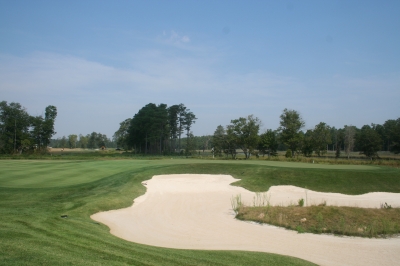 |
| Luckily, this bunker does not front the green on the par three 16th hole. As is true with most holes at The Peninsula, you can miss to the sides, but you'll also have to get creative with your short game. |
Cope was careful not to make light of the situation, as both Fazio and Nicklaus have flawless reputations for scribing distinctive golf courses – but it also underscores the fact that most everyone (including non-golfers) has heard of Jack Nicklaus, and name recognition is important when putting in a golf course as part of a real estate development.
The end result of Goldstein’s selection of Nicklaus is a sight to behold. The Peninsula is a big course – big waste bunkers, big greens complexes, big fairways, big yardage, big views and big in the ‘enjoy-ability’ sense. It’s a private course intended for the use of the gated community’s residents and members. Lucky them, we’re envious. But it was important to see The Peninsula for its place in the Delaware shore’s golf product – and it’s right up there near the top.
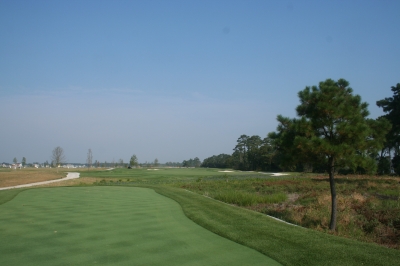 |
| Don't go to a Nicklaus designed course without expecting some big par fours. Here, the 460-yard 8th hole. |
There’s plenty of nature around, and the setting is a large part of that. Thankfully for the residents (and golfers, too), the set-backs on the corridors are exceptionally wide.
Cope talks about the Nicklaus group’s initial impressions of the property: “When we first saw the land, it became obvious that the peninsula nature of the property would allow us to route a lot of the golf holes along the various river systems on three sides of the property. We then only had to design the other half of these holes to compliment what Mother Nature had already ‘designed’ along the river half.”
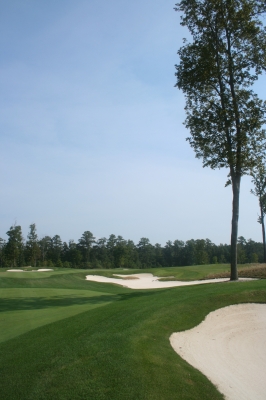 |
| Another 'big' par four is the 495-yard 14th hole. It's a long way from tee to green, but there's a lot of playing room to soften the difficulty. |
It’s always nice when Mother Nature ‘volunteers’ to do half the work, but Nicklaus throughout his playing career was all about percentages. He believed if you could move your golf ball with a fade or a draw that you automatically eliminated half the trouble on every golf hole. Though not quite the same thing, leaving half the ‘beauty’ to the land’s natural gifts was a very smart thing to do – especially at The Peninsula.
“Every project is different because every piece of land is different,” Cope said. “Our job is to find the best golf course that already exists on the property and work from there. In The Peninsula’s case, the Indian River set the tone of the course and we just worked that theme throughout the golf course.”
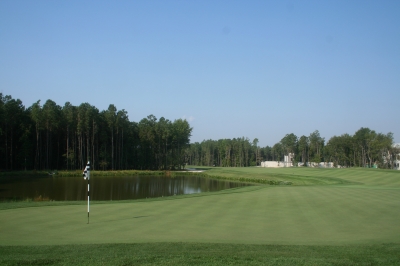 |
| John Cope said Mother Nature designed 'half' of every golf hole, and the par four 6th hole is a good example of nature's good work. |
And because of the lowland nature of the land, managing the groundwater and drainage would certainly be a challenge as well. Cope said they had a wetter than usual season when building the course, but otherwise, construction went smoothly.
As would be expected, there were environmental concerns to adhere to. “There were both local and federal wetland delineations that we had to keep in mind and work with during construction,” Cope said. “We also created a lot of wetlands and other holding areas in order to conform to the regulations for storm water management. These features were used in the strategy of the golf course and added further interest to the design.”
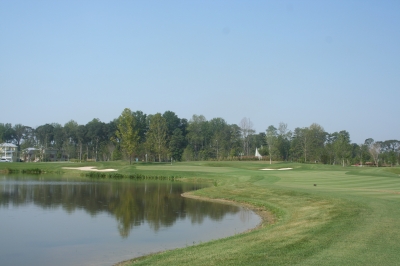 |
| The 459-yard, par four 11th is a sweeping dogleg left, with water carries off the tee and on the approach. |
That’s an understatement. Water and wetlands appear on seventeen of the eighteen holes (twelve is the exception), so it’s never far from your thoughts, especially from the back tees. Not to mention the glorious vistas of the Indian River Bay from several holes on the front nine. Despite the prevalence of the rivers, ponds and reeds, there’s plenty of room to play the ball, and overall, the course is very forgiving in the lost ball sense.
But aren’t all these characteristics a Nicklaus trademark?
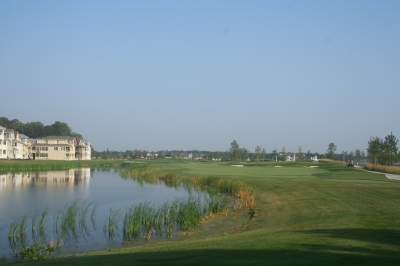 |
| You won't ease into the round at The Peninsula, as the 581-yard, par five 2nd hole is rated the course's hardest hole. |
Not according to Cope. Nicklaus doesn’t want to be type-cast: “Jack doesn’t like for any of his Signature Golf Courses to have trademarks that distinguish them from any of his other designs. The last thing he wants is for a golfer to stand on the first tee, look down the fairway and say ‘I see this is a Jack Nicklaus-designed course.’”
“With that said, Jack is known as a second shot strategist, and The Peninsula fits his philosophy well. His risk/reward thinking sets up well off the tee and requires the golfer to flirt with trouble in order to set up the best shot into the green. Everything that the player needs to decide the best way to attack each golf hole is visible from the tee box,” Cope added.
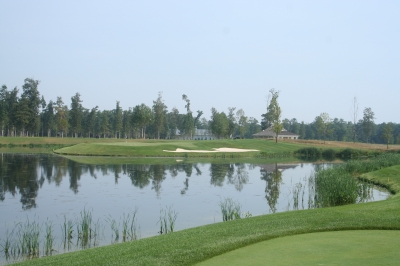 |
| The par three 13th hole is a 'Peninsula' all its own. From the back tees, it's 190 yards of water to carry. |
Like most recent course openings (The Peninsula opened in late April, 2006), there’s plenty of golf real estate. Nicklaus may not be known for ‘trademarks’ on a golf course, but his thoughts on equipment technology and the way it’s changing the game are well documented. These days, in order to challenge the best players, you need length, and the Peninsula has it – over 7,300 yards worth.
But only from the back tee would The Peninsula qualify as daunting (there are four sets of tees) – and that’s exactly the way that Goldstein wanted it. “The community at The Peninsula is family-oriented, so we tried to achieve a very member-friendly golf course. We did this by creating smaller greens with larger bail-out areas around them. This gives the higher handicap player a larger target area to get around in bogey fashion while at the same time keeping it challenging for better golfers who are playing for par or birdie,” Cope explained.
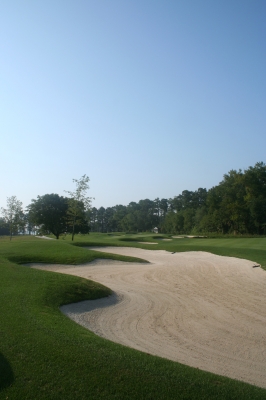 |
| You won't lose a lot of golf balls at The Peninsula, but that doesn't mean there aren't hazards to contend with. Here, a fairway bunker on the par four 4th hole. |
Troy Flateau, The Peninsula’s Director of Golf, echoed Cope’s words when describing the layout’s challenges: “Each tee shot has some sort of visual intimidation, whether it’s a deceiving (in the length sense) carry or the water that can be seen to the sides on many of the holes. Once the player reaches the fairway, however, they’ll realize there was more room to hit it than they thought.”
“And the course can play much different day-to-day, depending on the wind conditions,” Flateau added.
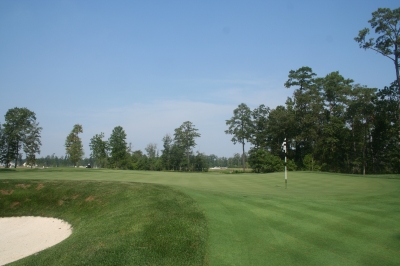 |
| Looking back from the green of the short par four 15th hole. At 338 yards, it's probably the back nine's best birdie chance. |
Flateau pointed to an additional player-friendly element at The Peninsula – the absence of deep rough around the greens. Those bail-out areas that Cope alluded to above are that much more welcome because of the variety of shots you can hit from them, including utilizing your putter. The greenside bunkers are also relatively flat by today’s standards, so you won’t always have to shoot straight up out of them.
Adding to The Peninsula’s considerable gifts is its management. Flateau didn’t ask me to include a plug for Troon Golf, but you can’t go to a Troon facility without noticing the superb quality of the service from drive-in to drive-out. The Peninsula staff did the things you’re supposed to do at a club, whether it’s private or not – and that includes a very friendly overview of the course from the starter, and some accoutrements that make every round more trouble-free, such as divot repair tools, tees, ball marks and towels.
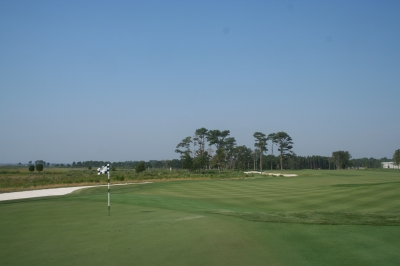 |
| Jack Nicklaus doesn't name 'signature' holes, but if he did, the bay-front par five 7th hole would get a lot of votes. |
And needless to say, for a new facility, The Peninsula was in outstanding shape. What a joy to play on surfaces like these. Kudos to the Superintendent, Craig Werline. The course was firm and fast, so it played somewhat shorter than the yardage.
Hole highlights include the par three fifth hole measuring 194 yards from the back tee. The shot’s all carry over a wetland and the green looks tiny in the distance, with the bay as the backdrop. There’s a lot of room to bail out right, but that will leave a very difficult up-and-down.
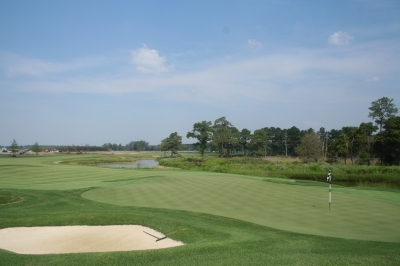 |
| Risk-reward opportunities abound on the par five 18th hole. |
The par five seventh is the one you’ll remember most from The Peninsula, as it runs along the Indian River Bay. Sand stretches from tee to green – encompassing one huge waste bunker, but the sand also helps you aim away from the trouble. The approach is deceiving with bunkering short of the green, and the wind can play havoc with your distances to this long but narrow green.
The back nine is longer, and the day we played was into the wind on some of the toughest par fours, so save some strength for the ride home. The par three 13th hole is one of the more intimidating holes on the course. It’s not an island, but it almost looks like one from the tee, and you’ve got 190 yards of water to fly to reach dry land (again, from the back tee).
The par five eighteenth is a great way to end the round. “Players must choose their shots wisely on this tricky par five with a small and undulating green. Jack Nicklaus said the 18th hole at The Peninsula will become the Pebble Beach of the east,” Flateau said. The hole has a similar right to left curve like the famous closing hole on the California coast – so you can see the comparison.
All around, The Peninsula is a pleasant country club experience – and if you’re looking for an eastern shore golf community with a terrific course and excellent service, it’s certainly worth the time to check it out.
And your mom would tell you exactly the same thing.
Details:
The
Phone: 302-947-4760
FAX: 302-947-4813
Website: peninsuladelaware.com
Course Designer: Jack Nicklaus
Nicklaus’s Design Associate: John Cope
Director of Golf:
General Manager: Laura Scrivner
Superintendent: Craig Werline
Tees/Yardage
Black 7302
Gold 6601
Silver 6248
Jade 5267
Memberships:
Membership Director is Monte Schisler
You must be a homeowner to be a member, and there are three levels of membership:
Social: $7500
Sport: $30,000
Golf: $60,000
Club Amenities Include:
30,000 Square Foot Clubhouse
Swimming/Tennis/Fitness
| Related Links | Comments on this article? | |
|
Maryland National Golf Club Hollow Creek Golf Club Rocky Gap Resort PB Dye Golf Club in Ijamsville Whiskey Creek Golf Club |
E-mail Jeff Rendall, Editor: jrendall@golftheunitedstates.com |












